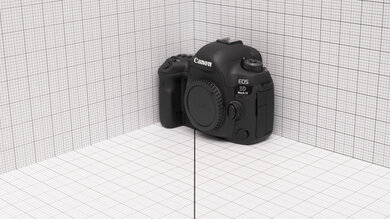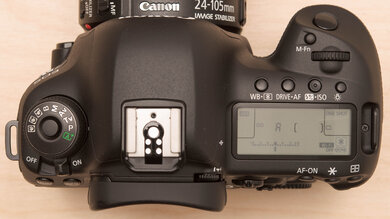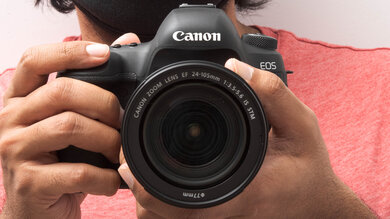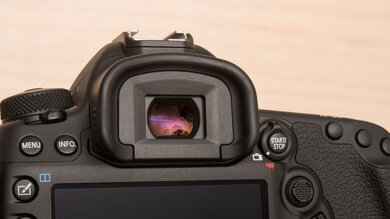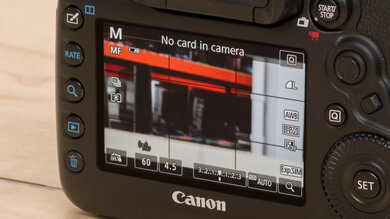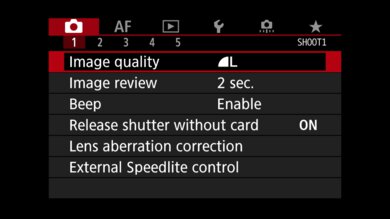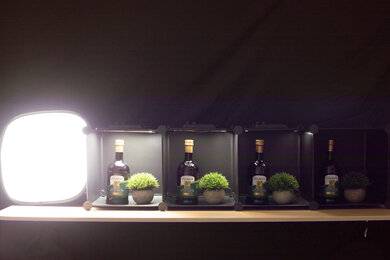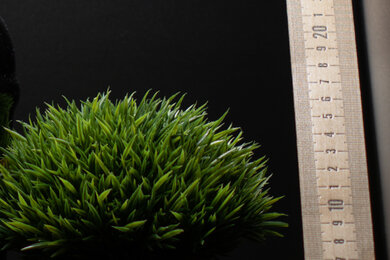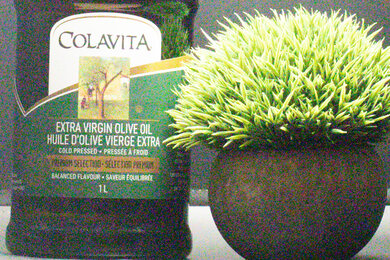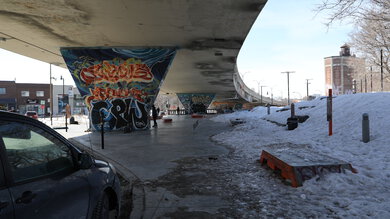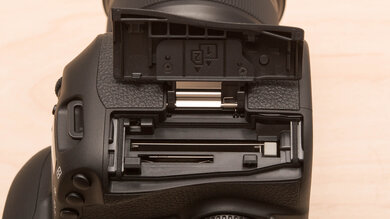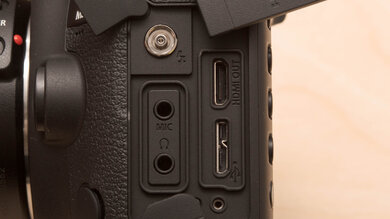The Canon EOS 5D Mark IV is a high-end full-frame DSLR camera. It offers impressive image quality, a sturdy and comfortable-to-use construction, and good video recording quality in 4k, though video shot in that format does incur a rather severe crop. Its autofocus system is decently effective and reliable in photography but performs exceptionally well in tracking moving subjects while recording video. Unfortunately, this is a very bulky, heavy camera, and its fixed screen is an inconvenience when trying to record video of yourself or when you're shooting from unconventional angles.
Our Verdict
The Canon 5D Mark IV is decent for travel photography if you don't mind a bulkier kit. Image quality is great, with a wide dynamic range, good color accuracy, and good noise handling in low light. Its autofocus system does a decent job of tracking moving subjects, though it performs more consistently when shooting in Live View mode instead of the optical viewfinder. It feels comfortable to hold and is also quite well-built, though its bulky construction can make it a hassle to carry handheld for long periods.
- Great image quality.
- Sturdy-feeling, comfortable-to-use design.
- Bulky, heavy construction.
- Fixed screen can't be pivoted to let you see it at an angle.
The Canon 5D Mark IV is good for landscape photography. It takes images with wide dynamic range, good color accuracy, and little loss of detail, even at high ISO levels, which is great for nighttime shoots. It has a sturdy-feeling construction that's rated as being weather-sealed.
- Great image quality.
- Sturdy-feeling, comfortable-to-use design.
- Great dynamic range.
- Bulky, heavy construction.
The Canon 5D Mark IV is decent for sports and wildlife photography. Its maximum continuous shooting speed can't really compare to the fastest-firing mirrorless alternatives, but it can clear its buffer very quickly, so interruptions following continuous bursts aren't too disruptive. Its fast maximum shutter speed and decently-effective autofocus system are helpful features that help you capture clear stills of fast-moving subjects. Overall image quality is also great.
- Great image quality.
- Sturdy-feeling, comfortable-to-use design.
- Fairly quick burst shooting.
- Bulky, heavy construction.
- Fixed screen can't be pivoted to let you see it at an angle.
- Silent shooting mode is still rather loud.
The Canon 5D Mark IV has great RAW image quality. Photos have plenty of fine detail, giving you some leeway to crop in, thanks to its high-resolution sensor. Its dynamic range is also great, so it captures a wide array of highlight and shadow detail. It also has good noise handling overall, though it doesn't perform as well when it comes to managing noise in low light as newer full-frame sensors.
- Great dynamic range.
- High-res sensor gives you some leeway to crop.
- Good noise handling.
The Canon 5D Mark IV isn't designed for vlogging. Since its screen is fixed, you can't see what's being displayed when the camera is pointed at you. It's also quite bulky, which can make it a challenge to carry around for long periods. Also, while it does a decent job of smoothing out camera shake in FHD, handheld footage can be quite shaky in 4k. Shooting in 4k also incurs a severe crop, though thankfully video quality is sharp and clear in this resolution. Unfortunately, the rolling shutter effect is quite apparent when shooting in FHD, which can distort subjects when panning side-to-side rapidly.
- Great video autofocus performance.
- Very good video quality in 4k.
- Good video stabilization performance in FHD.
- Shoots 4k video with a severe crop.
- Bulky, heavy construction.
- Struggles to smooth out camera shake in 4k video.
- Fixed screen can't be pivoted to let you see it at an angle.
- Noticeable rolling shutter effect in FHD.
The Canon 5D Mark IV is relatively good for studio video, though this isn't its main intended use. Despite the severe crop that comes with recording 4k video, footage is sharply-rendered and low in noise, even when shooting in dimly lit environments. The autofocus system also does a great job of maintaining focus on moving subjects. There's also a wide selection of ports and inputs for various videography accessories, including headphone and microphone jacks. It has a clean HDMI output that lets you record footage using an external recorder without any overlays. Its menu system is also very easy to navigate and features a guide mode to help explain some core functions.
- Great video autofocus performance.
- Easy-to-use menu system.
- Wide selection of inputs and outputs.
- Very good video quality in 4k.
- Shoots 4k video with a severe crop.
- Heavy crop in 4k.
The Canon 5D Mark IV isn't designed for action video. It's too big and bulky to be mounted on a camera or chest rig and can only record 4k video with a severe crop. It's also incapable of recording at high frame rates for generating smooth slow-motion footage. The rolling shutter effect is quite noticeable when shooting in FHD, which can distort subjects when panning side to side. On the plus side, it feels well-built and has a weather-sealed construction, though we don't currently test for that.
- Very good video quality in 4k.
- Good video stabilization performance in FHD.
- Shoots 4k video with a severe crop.
- Bulky, heavy construction.
- Struggles to smooth out camera shake in 4k video.
- Noticeable rolling shutter effect in FHD.
Changelog
-
Updated Jan 10, 2025:
We added a comparison to the newly reviewed Nikon D850 in the Photo AF-C Tracking test box.
- Updated Jul 18, 2024: We corrected an error with the Lens Mount of this camera from 'EF/EF-S Mount' to 'EF Mount.'
- Updated Jan 29, 2024: Added text to the 'Raw Photo Performance' verdict box and updated existing verdict boxes for clarity and accuracy.
- Updated Jan 29, 2024: Converted to Test Bench 0.12.1.
Check Price
Differences Between Sizes And Variants
The Canon 5D Mark IV is only available in one color variant: 'Black', and you can see its label here. We tested it in conjunction with the Canon EF 24-105mm f/3.5-5.6 IS STM lens, though other EF-mount lenses can be bundled with the camera body. You can also purchase it without a lens at all. For an additional fee, you can also purchase it pre-installed with the C Log gamma setting, which lets you capture images with a wider dynamic range and allows for in-depth color grading when editing video. We haven't tested this variant or any other configuration of this camera.
If you come across another variant, let us know in the discussions so we can update our review.
Popular Camera Comparisons
The Canon EOS 5D Mark IV is better overall than the Canon EOS 6D Mark II. Both are excellent DSLRs with full-frame sensors, though the 5D Mark IV's sensor has a slightly higher resolution. The 5D is aimed more at professionals, with a bulkier, slightly sturdier build and dual memory card slots, a faster max burst rate, and 4k video capability. The 6D Mark II still offers great image quality and may offer more bang for your buck if you don't need features like 4k video or prefer a fully articulated screen.
The Nikon D850 is better overall than the Canon EOS 5D Mark IV, though both are excellent pro-grade DSLRs with well-established lens ecosystems. The Nikon's backside-illuminated sensor gives it a wider dynamic range and higher resolution than the Canon's sensor. Aside from the differences in their sensors, however, both cameras are robust, with excellent ergonomics, and capable of capturing professional-quality images.
The Canon EOS R6 Mark II is better overall than the Canon EOS 5D Mark IV, but they're both fantastic cameras suitable for professional use. The R6 Mark II is a newer mirrorless camera with a more sophisticated autofocus system and faster burst rate, making it a better choice for sports and action photography. It also has better noise handling for low-light situations. That being said, the 5D Mark IV has a more established lineup of native lens options that you can use without an adapter, including more affordable options. It's also a bit more tank-like in build, so it can withstand more extensive use. Plus, it's a DSLR, so it has a longer battery life, and you don't have to worry about lag or eye strain with its optical viewfinder.
While these are both premium Canon DSLRs, they're differently classed. The Canon EOS 5D Mark IV is a professional-grade camera with a larger, sturdier build and a full-frame sensor, whereas the Canon EOS 90D is a mid-range camera with an APS-C sensor. The 5D Mark IV is overkill for most people, especially considering its size and weight. Because the 90D is a newer model, it offers a few advantages in areas like battery life, autofocus performance, and burst speed.
Test Results

- Well-textured hand grip is large and thick
- Plenty of room for a wide variety of hand sizes, so fingers shouldn't get pinched between the body and lens
- Large backrest to rest your thumb
- Dedicated controls for shutter speed, aperture, and ISO
- Camera is quite heavy, with weight pulling towards the front left of the camera when it's held solely in your right hand
- Fixed screen can't be moved into a more convenient position when shooting from unusual angles
- Menu is easy to navigate with physical buttons or with inputs on the touchscreen
- Guide mode helps provide a brief explanation of some functions
- Q menu lets you quickly access frequently used features and settings
- Dedicated autofocus menu is also rather easy to navigate
If you need a more reliable autofocus system but still want a heavy-duty pro-grade DSLR, consider the Nikon D850.

